#artmaking and exhibiting
Photo







Here are some pictures from my last show taken by the talented photographer Victoria Doyle. ‘A floating cloud’ is still slowly unravelling conceptually as I am trying to distance myself from it to try and better understand the contention of spontaneous art making. Acknowlegdement of the thought process from within the subconscious (which is literally brimming with ideas) does not always concur with immediate self-expression. Quite the opposite in fact. The element of inconsistency in my work has in time led to many artistic urges going amiss forever. The piece speaks to the instability of our creative practice and the fraught dialogue between ratio and sentience as vehicles of aesthetic surrender.
0 notes
Text
Staff Pick!

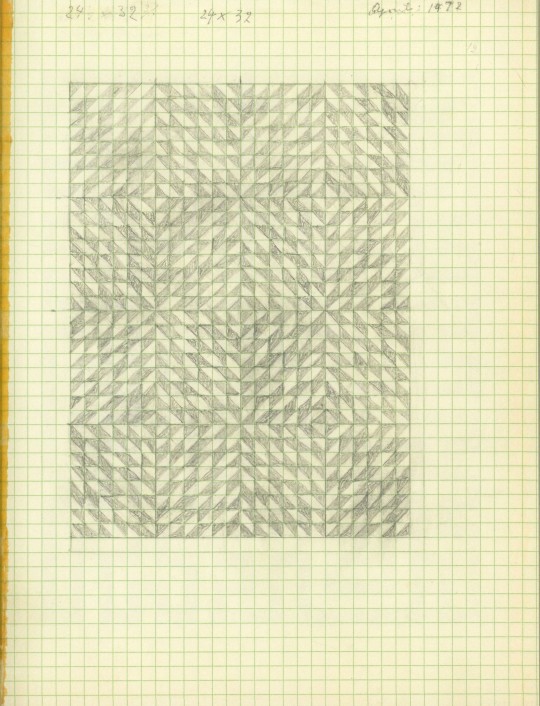



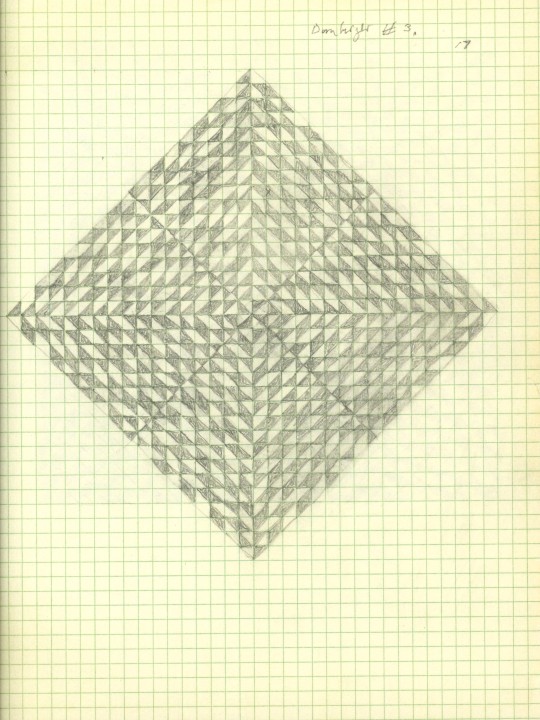
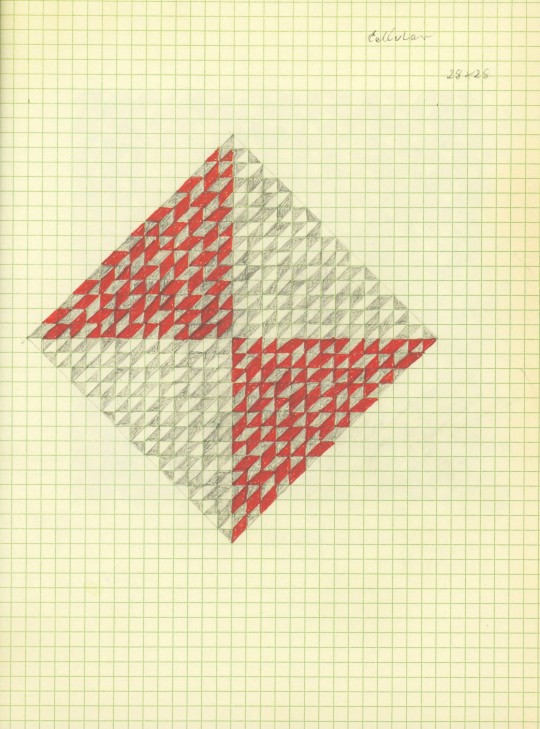

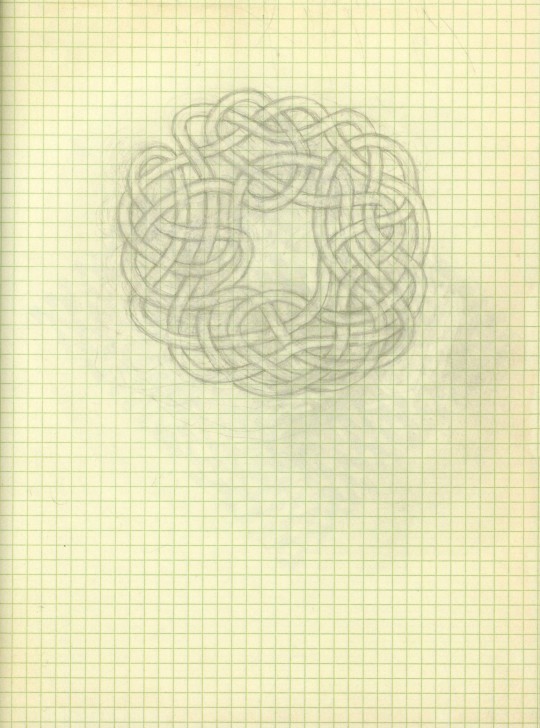

Anni Albers (1899-1994) is held in high regard as one of the most paramount textile designers of the 20th century. Albers attended the Bauhaus in 1922 and begrudgingly participated in the weaving workshop as it was the only one available to women at that time. By 1931, Albers had received a diploma for innovative work and stepped into the role as head of the weaving workshop, a rare occurrence for a woman at the school. When the Bauhaus closed in 1933, Albers accepted an invitation to teach at North Carolina’s Black Mountain College. She stayed on as an assistant professor at Black Mountain College until 1949 where she was known for her experimental approaches to materials and processes.
Albers broke new ground within the world of weaving and graphic design, taking printmaking techniques into uncharted territory. In 1949 she was the first textile designer to have a solo exhibition at the Museum of Modern Art and spent the remainder of her life making and showing art. Despite her prolific artmaking, Albers left behind very little evidence of her working process aside from one unassuming notebook dating to the latter part of her life.
Anni Albers: Notebook 1970-1980 is a delightful glimpse into the mind of Albers. A facsimile of her simple composition notebook, the publication is replete with spontaneous works and preliminary ideas sketched out in pencil and occasionally red ink. Most works are dated, and a few have titles corresponding to subsequent prints and printed textiles. This is the only known notebook of Albers and a joyous wellspring of inspiration for any textile artist or designer.
Anni Albers: Notebook 1970-1980 was published in 2017 by David Zwirner Books out of New York.
View more staff picks.
-Jenna, Special Collections Graduate Intern
#anni albers#anni albers: notebook 1970-1980#David Zwirner Books#bauhaus#black mountain college#textile design#weaving#staff pick#Jenna
137 notes
·
View notes
Text

Portrait of Kahlil Joseph, Acrylic on canvas (2019) by Henry Taylor
For more than thirty years, the Los Angeles–based artist Henry Taylor (b. 1958) has portrayed people from widely different backgrounds—family members, friends, neighbors, celebrities, politicians, and strangers—with a mixture of raw immediacy and tenderness. His improvisational approach to artmaking is hinted at in this exhibition’s title, Henry Taylor: B Side, which refers to the side of a record album that often contains lesser-known, more experimental songs.
The exhibition Henry Taylor: B Side runs until Januari 28, 2024 at the Whitney.
#art#painting#henry taylor#los angeles#california#kahlil joseph#whitney museum#manhattan#nyc#new york#usa
12 notes
·
View notes
Text

Random...
And there goes another one from my email box, unsubscribed... Now, this is twofold. First, I am really trying to clear some clutter. I love the DIA (Detroit Institute of Arts, for those of you not from around here), but I don't find myself reading any of their emails. Doesn't mean I'm not gonna go get my Renaissance masters on at some point when I feel like so doing. But seriously, ask yourself, if you had a magazine arriving in your mailbox that you never read, how long would you keep that shit going, even though email is much easier to quickly delete. Simply put, if you're not using something... AND it brings you no joy (that's for the decorative items in your life), why are you keeping it around?
The second, of course, is the nature of the content, this pandering word salad for the month of June. Now, I'm gonna go ahead and just fast-forward to the perpetual strawman, "but straight cisgender artists are celebrated the other eleven months out of the year"... no. No they are not. ARTISTS are celebrated. When you have a Rembrandt exhibition, you are celebrating an artist. Not a "member of the white male heterosexual cisgender community", an artist. One of the grand masters of the Dutch golden age. We'll even push off the fact that we actively 'celebrate' black, female, and gay artists in certain respective months, but not white, male, or straight ones...
What it boils down to is a tragic dissolution of any kind of exceptionalism in favor of defining everything by a sexuality, gender, race, etc. Which, by the way, are some of the most catastrophically boring attributes to define someone by. I mean, look at the artist profile for the artmaking section, second one down, and skip the bullshit. "Jamie, a... ... ... ... ... ... ... ...
...
...
... ... ... ...
...artist".
Skipping the bullshit. What does this tell me about him? His artistic accomplishments? His qualifications as an expert on the subject? Absolutely fucking nothing. Is he even in any way qualified, or is his sole claim to fame a bunch of word salad entirely unrelated to artistry? Yes, your personal life experience flavors your work, outlook, etc., it is a definite contributing factor... but we're not even playing that game here. We're just saying, in this case, he's a gay Korean indian, and that's good enough, and you're presumably a bigot if you disagree.
Call me crazy, I just think we can do better than defining somebody entirely by where their ancestors came from, what they have between their legs, and who/how they want to fuck or get fucked. I feel like there are a lot more compelling aspects of an individual that we can work with than those. 🥔
3 notes
·
View notes
Photo

ALL OVER THE PLACE
If the medium is the message then what does video mean? Pioneering works from the 1970′s and 1980′s challenged artmaking practice head-on. Today anyone with a cellphone camera is both both auteur and connoiseur. MoMA’s retrospective Signals: How Video Transformed the World presents the form hopefully as “an agent of global change—from televised revolution to electronic democracy.” But the exhibit itself lacks a punch.
The show is spread over two floors, where monitors are stacked, set in circles, mounted on trusses, and dangled from the ceiling. Their flickering lights cast a soft glow and give an unnerving sense that seas of pixels are being transferred seamlessly all around, right through one. There are so many works to take in that one floats from piece to piece in a kind of ennui. Many of the works themselves, from an era before the cellphone, feel sternly educational or hopelessly innocent.
And where is the beauty? The dominant aesthetic is discontinuous, jagged, placeless, crooked, sliding in and out of view. In contrast to film, its sister medium, there are no characters and there is no real beginning or an end. And at the museum everything is cast in silence, experienced alone, with audio accessible only through headphones.
But two videos by Sondra Perry, spooling on breadbox-sized monitors on low platforms near the exit, chart a new course. In each an artist dressed in a white Hazmat-type suit that renders them invisible to security cameras gyrates feverishly in the corner of a white room. Observed from above, their hypnotic dances obscure any rendering of face or figure. Their white suits register as soft smears against the screens, erasures. The dancers themselves become emblems of resistance, fury and grace.
While art commands attention video has a dangerous transparency. Seeing charged political imagery (protest, warfare, famine, bigotry) in a museum ennobles and also trivializes. We pass screens on the street and scroll reels on our phones and mostly don’t pay attention. For the medium to wield real power, politically and artistically, it needs to have purpose and presence, just as Perry’s pieces do.
Sondra Perry, Double, Quadruple, Etcetera, Etcetera I (video still), 2013
HD single channel video loop, color, silent. Courtesy of Sondra Perry.
3 notes
·
View notes
Note
can i hear about your school art gallery job?
hii chels sure!
so I'm a student worker at my school's art galleries. I got the job in february, but couldn't work until June because I had to jump through a bunch of international student worker hoops.
I really like the job! I do installs and removals (which is cool cause i get to be part of artmaking and also learn how to use power tools), reception (where i walk around and make sure nothing goes wrong during exhibition openings), and front desk (where I sit on a regular day mostly doing nothing but welcoming guests to the gallery or reading articles)
I'm mostly just happy to be working again, it had been a really long time. And I like being up close and personal with the art my peers make. and i like getting paid
#but sometimes. artists can be the worst. don't tell anybody#she speaks#thanks for asking i hope those tags didn't seem like bait 😭
4 notes
·
View notes
Text

Registration is Open!
Kolaj Fest New Orleans is 7-11 June 2023
Kolaj Fest will return to New Orleans on 7-11 June 2023 for a coming together of collage artists and art professionals; a multi-day festival and symposium about contemporary collage and its role in art, culture, and society; where the focus is how we celebrate and elevate the status of collage. Presenters will lead panel discussions and explore key curatorial issues. Artists will exhibit artwork, and create special activities and demonstrations. We will meet, network, share community, camaraderie, and fellowship. We will leave armed with new ideas for our artmaking, writing, and curatorial projects, but more importantly, we will leave Kolaj Fest New Orleans prepared to champion this artform in the year to come.
LEARN MORE | CALLS TO ARTISTS | REGISTER
*****************************
Kolaj Magazine, a full color, print magazine, exists to show how the world of collage is rich, layered, and thick with complexity. By remixing history and culture, collage artists forge new thinking. To understand collage is to reshape one's thinking of art history and redefine the canon of visual culture that informs the present.
SUBSCRIBE | CURRENT ISSUE | GET A COPY
SIGN UP TO GET EMAILS
#collage#collage art#collage artist#art#artist#art history#art project#streetart#art show#vintage art#art books#art education#book art#artistic#contemporary art#artwork#modern art#fine art#artist residency#artist books#contemporary artist#artist portfolio#artist book#artist profile#artist collective#contemporary artists
3 notes
·
View notes
Photo
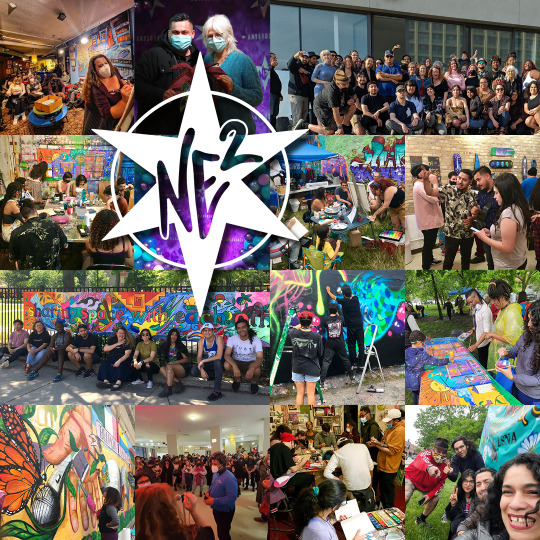
Dear Friends of AnySquared,
Some of you are friends we’ve featured in exhibitions, some we’ve met at events or studio days, and some we’ve collaborated with on your projects – many are friends from the community. You are why we exist and your support is essential for us to continue our work.
This December marks our year anniversary of formalizing AnySquared as a nonprofit 501c3! We are grateful to our board of directors for doing the work to make this happen–the board is made up of six dynamic individuals who are involved in community-based organizations and arts related projects. As a nonprofit, we can create new networks of support for Chicago artists and generate compelling and meaningful programming that gives artists a chance to leverage their art to organize for the greater community good.
Please scroll through to see what AnySquared has been doing this year!
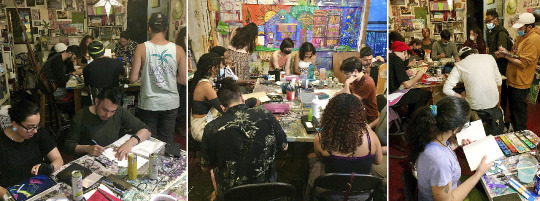
Artists from all over the city attend AnySquared’s weekly Wednesday Studio Days. Participants tell us that there is no other art day like ours in the City of Chicago. We provide free supplies while offering the studio space and encouraging creativity and collaboration. In 2022 we were excited to be open all year and hosted 50 Studio Days with 20–30 mostly young artists attending each week! instagram post 1 | instagram post 2 | instagram post 3
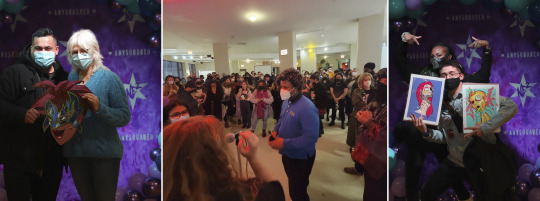
Art community events like AnySquared Art Swap Meet last February are reaching bigger audiences and more artists citywide. Over 250+ people attended the Art Swap that featured 110 artists swapping art. Block Club Article announcing Art Swap | instagram post | facebook artists album

Life & Love in Covid Times opened in March as our 1st exhibit for Art at Coles since the pandemic! Featuring 50+ artists including some we have never worked with before, it was a great way to connect in addition to Studio days. We also hosted 2 other Art at Coles later this year that hightlighted 3-4 artists each in these exhibits: Art at Coles #42 and Off the Streets!
We hosted 30 art talks to check out on YouTube through March of 2022, See the fantastic lineup of artists of all experiences! AnySquared Spotlight Art Talk Series
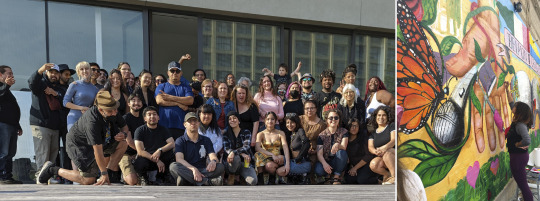
Looking to the future as a nonprofit: Our amazing Visioning Session in June gave the whole of the AnySquared network a platform to workshop and voice ideas about the direction of our organization as a nonprofit. We continue to roll out different aspects discussed including implementing monthly meetings, opening the studio additional days, initiating the planning for the Belmont Cragin Community Mural, and creating more avenues for more artists participation in programming and proposing projects. Thank you to Studio Gang for the rooftop space! facebook video
We continue to partner with Chicago artists, projects, and organizations in the community.
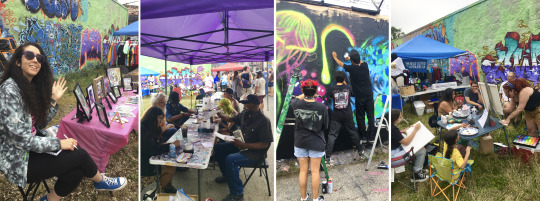
The annual Against Da Fence mini-art-festival is our biggest collaboration of the year and is a testimony to cooperation with Renegades of Funk and our combined communities at Project Logan. 500+ people in the community came through to see art on the fence, painting on the wall, art vending and demonstration by 75+ artists as well as participate in our art-making activity. See 2022 Facebook album with extra photos!

This year we were proud to be recruited to collaborate on two projects with Palenque LSNA — an excellent community organization that fights for affordable housing, immigration rights, and better schools. Our team created a beautiful mural banner to be carried at Palenquefest. We also organized arts programming at the May festival including artmaking for families, an artist showcase, a “here to stay” community banner painting activity, and more than a half dozen live artists. It was a true collaboration of art plus community on a rainy, but fun day!

Palenque LSNA also asked us to create community alter that honors those killed by gun violence in 2022 for the Viva La Vida: Day of the Dead event at Comfort Station in late October. Our lead artist was Cesar Luna who designed and created the beautiful ofrenda for Dia De los Muertos.

Once again we collaborated with Unity Park for Art in the Park and provided volunteers, organized the painting activities of the day, and completed the “making space for each other” banner mural painted by the community and designed by Helen Sanchez-Cortes who was also the lead organizer. It was a beautiful day of art + community.

We continue to supported up-and-coming spaces and emerging artists with our collaboration with Studio Nez for the Breakfast Show exhibit.
It was great to partner with Casa Hernandez’s Nick Hernandez who donated their space for the Passions Skateboard Art Show curated by Cesar Luna! The space usually hosts Humboldt Park Solidarity Network‘s free store thanks to Nick and community members!
This year we also sponsored a pilot Arts Administration Internship Program and plan to create and fund more mentorship opportunities and skills workshops in 2023. For next year we hope to create paid intern positions for communications manager and art studio manager. Internships help develop real world skills for young people interested in arts administration but we need your support to make these positions a reality.
Throughout the year we continued to amplify our fellow artists and collaborators in our wider network through 100s of social media stories and posts in the Milwaukee Avenue Arts News.
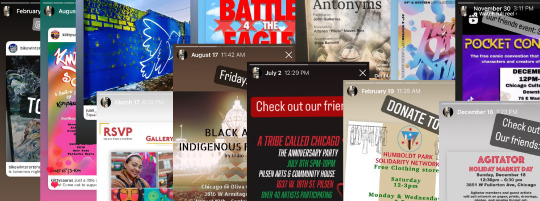
While we currently remain in our AnySquared Studio space, and are beginning the process of investigating the possibility of spaces – but we understand we need to build out our fundraising capacity. We will see rising operations costs in 2023 and have already experienced a rise in costs for art materials. We have traditionally raised money through our own efforts and in 2023 plan to make a push to seek out monthly sustainers and grants which will help us to expand our programming and provide more consistent stipends for interns and artists.
Will you join in supporting AnySquared by making a year-end donation? Help AnySquared in changing circumstances! Please consider making a generous tax-deductible donation to AnySquared.
You can also become a Monthly Sustainer at $10, $20, $50, or $100 to help Anysquared move towards attaining important financial sustainability. As a monthly sustainer you help make sure we continue to do the great work we have been doing in Chicago!
Donate through Square OR PayPal. We also accept CashApp ($anysquared). Checks can be mailed to: AnySquared, 2328 N. Milwaukee, Floor 2, Chicago, IL 60647.
That's a Wrap for 2022! Next year will be AnySquared’s 13th Anniversary. We are excited about planning new projects in the new year. Look for our website update with artists' directory too!
Wishing you art plus community.
Thank you for your support!
___
AnySquared.com
@ne2_gallerysquared
[email protected]
News & Events | YouTube
Find AnySquared on Facebook, TikTok, Twitter
Supporting and nurturing artists and creating community for more than a dozen years, AnySquared is an artists collaborative and artists network. AnySquared's mission is to support, produce and promote collaborative projects that facilitate arts activities through inclusive participation.
2 notes
·
View notes
Text

Karoline Hjorth & Riitta Ikonen
The Lore of the Land
Karoline Hjorth and Riitta Ikonen play with the porous border between human and nature. They create portraits of older people wearing sculptural costumes made from vegetation they find around them in the landscape. Each image is an enactment that grows from a collaboration with the subject and the relationship that person experiences with their surroundings. However strange or whimsical the final image may at first seem, what lies beneath the surface is a fearless receptivity. The photographs – and perhaps the subjects themselves – draw their strength from the landscape in which they reside.
Collected into two books made over the past thirteen years, and featured widely in exhibitions and the media internationally, the work forms an ongoing extended series called ‘Eyes as Big as Plates’. While the title draws on a Nordic folk tale, it was chosen to reflect the wide-eyed curiosity that guides the duo in their artmaking. Each portrait is, as they say themselves, a kind of adventure.
Karoline Hjorth and Riitta Ikonen rediscover the lore of the land at Talking Pictures.
#photography#photographer#creativity#art#artphotography#photographerinterview#photographerinterviews#riittaikonen#karolinehjorth#eyesasbigasplates#norwegianphotographer#finnishphotographer#norwegianphotographers#finnishphotographers#talkingpictures#womenphotographers#photographylovers#nature#sustainability#naturelover
0 notes
Text
Art Studio 1 Technical Group Lecture: Communication (6.5.24)
Lecture (by Joshua Boerma)
Communication is important for every stage of artmaking, especially:
When pitching your artwork
When speaking to a curator
During a job interview
Installing your final work/s for an exhibition
In instances where you need to outsource services (e.g. printing, hiring equipment/studios, metal/wood cutting) or materials.
Think about communicating things about yourself to your audience (curator, supplier, art audience, etc.):
Are you planning your tone to be formal/informal?
What medium are you planning to communicate through?
Note that writing an email is not the same as text messaging your friend.
Introduce yourself.
Be considerate of the other person's time.
Be prepared and know what you want. (Are you are student? Are you a business? If you are not studying, you should consider yourself as a commercial entity or a professional entity. Even if you aren't an expert in the field.)
It is ok to say you don't know something. It is better to ask for clarification.
Language is important. Where possible, modify your language to the scenario.
If requesting a service, communicate everything you need (dimensions, material quality/type, finish, etc.), consider the timeline for that service to be done, and always ask for a quote to confirm the full price. If possible, you may also need to ask for samples of the material to ensure that you know what you're getting.
Follow-up emails to confirm past phone calls are very helpful.
0 notes
Text


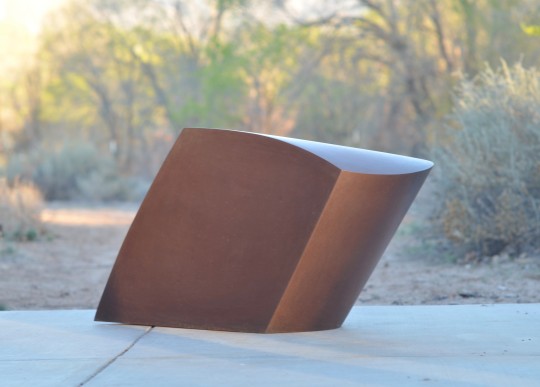
Tom Waldron: Steel and Concrete
April 26 - May 25, 2024
Opening Reception for the Artist: Friday, April 26, 5 - 7 PM
The eye follows a smooth plane, curving gently in pitch, slope on slope, sweeping to meet and create a line. A deep rust form tilts, leaning, forming a deeply shadowed side. A sharp, faceted arc sweeps to a point. Softly interwoven curves braid together in a column. A round oxidized shape seems to fold up on itself, caught in a moment just before it sprouts wings.
It is a trick of sculpture to put us squarely into the here and now. Mass. Volume. Weight. Sculptures inhabit space with us and we with them. They alter the air’s flow through a room. They radiate their own minute gravity. Fully art object, whether molded or cast, carved or welded, sculptures remind us that our world is multi-dimensional – not solely existing in the 2D hybrid mind/light no-space of our screens.
Tom Waldron’s work not only brings us to attention but challenges our perceptions with its deceptively simple forms. It is likely no surprise that Waldron’s entrance into artmaking was spurred by his love of the materiality and physicality of the process. The challenge and intense focus required of welding, it’s possibilities and generative power led Waldron to leave his studies in architecture to pursue sculpture.
Steel and Concrete brings together a disparate collection of Waldron’s work in different mediums. While he is best known for his steel pieces, this show also incorporates works in concrete, a dense gypsum plaster (Hydro-stone), and even in wood. The concrete and wood pieces have evolved slowly in relationship to the steel works. First, as simply materials for pedestals and bases. However, over time, sometimes the line between sculpture and pedestal would blur. Later, Waldron began to take some of the curved cardboard constructions that he creates as models for his steel works and use them as molds to cast concrete or hydro-stone pieces. In this format, Waldron saw the possibilities of using them like modules. Using wood allowed Waldron to explore wall-mounted work because of its lighter weight – but the medium also allowed him freedom to alter and find forms not possible in steel.
The pieces in Steel and Concrete, in each medium exemplify these different properties and effects – the steel pieces with their gently curved volumetric masses tend to encapsulate or bloom into space. Sledge, at over eight feet,and Agave, at five,seem like massive geometric creatures frozen in a moment of twisting growth. Ledge 2 tricks the eye into seeing a rectangular block from one angle – which then bulges and puckers from another. Mounted on a concrete base, Spoonful, inverts Waldron’s more familiar convex curves with a smooth concave scoop out of the sharp-edged steel square.
The concrete pieces included in the exhibition are all columnar – composed of regular interlocking shapes and modules which showcase the motion of uprising lift and rhythm. Shadow Column includes both a wood base and cap which contain a smooth, white, braided sculpture of hydro-stone within. Fan Column, on its wood plinth, is a complex composition of interlocking arced forms in alternating muted colors. His most recent piece, Six Color Column is comprised of gently curved blocks fitted together to create an undulating tower.
Finally, the wood piece, White Cloud 3, explores the same fascination with curved planes and elegantly intersecting lines as Waldron’s steel works – but makes good use of its lighter weight to create a more delicate shape that seems to sail out abstractly from the wall.
Step by step, each sculpture of Steel and Concrete leads the viewer through an experience, from objective observation through to subjective co-existence. Frozen curves intimate at the gentle slowing down of time. (We pause. We notice.) The density of the large steel works grounds our feet into the floor. (We find balance in space as they balance so elegantly in their twisted curved forms.) And the columns, rising slenderly toward human height, feel like fellow beings. (We stand with them, being.)
0 notes
Text
Whitney Museum is Free to Visitors of All Ages Sunday, February 11 with Artmaking Programs Led by Artist Dyani White Hawk
Photographs by Filip Wolak
Before the big game, families can explore the Whitney as part of Free Second Sundays, with artmaking programs led by artist Dyani White Hawk, a tour of the brand new exhibition Harold Cohen: AARON, and more!
The Whitney Museum is offering free admission all day on Sunday, February 11 and special programming in English and Spanish for visitors of all ages. The Whitney…

View On WordPress
0 notes
Text
Needless to say, we cannot undo the history of the museum, but neither should we invest blindly in its current state of affairs; we have to recognize it for what it has done, what it is capable of, and what it might do. Contra Adorno, the museum is no longer a mausoleum: His claim that the museum only exists out of “historical respect” has ceased to be the case. Indeed, the museum today is expected to be a center of attention and an active agent in culture to satisfy the “needs of the present,” but as much as it tries to stay up-to-date, it cannot help but deploy its age-old techniques—and this is not wholly a bad thing. After all, the museum is one of the few devices that can make the royal democratic, the private public, the sacred profane. It can switch contexts and create distance. It can bring things to light.
I am trying to argue here for the possibility of a productive alienation, a salutary anti-immediacy. In a sense, the museum reveals the artwork’s potential precisely by negating it: “Works of art,” Adorno insists, “can fully embody the promesse du bonheur only when they have been uprooted from their native soil and have set out along the path to their own destruction.” This is not quite as perverse as it sounds. Art is different than reality; it is one way of thinking about it and contemplating it. In his 1917 essay “Art as Device,” Viktor Shklovsky noted art’s strange-making powers, its ostranenie, its ability to defamiliarize. The device of art, however, resides not only in its objects but in its institutions—in other words, the artmaking, strange-making device par excellence may be the museum itself. And this strangeness, my substitute word for autonomy, is what grants the museum its privileged position not outside, but adjacent to, life—a place where life might be seen, queried, and discussed.
But must modern museums sit on endlessly growing piles of capital in order to do this work? Each expansion the museum makes not only creates room for more art but also builds a structure ever more costly to maintain—indeed, its incessant territorial expansionism might be one of its most colonial traits, apart, of course, from the encyclopedic museum’s mission to universalize (and centralize) by plunder. Hito Steyerl has written powerfully of what she calls the “poor image”—a digital file that is circulated, amended, shared, and cared for by many. What it loses in quality, in resolution, she claims, it gains in history. Now might be the time to imagine a “poor institution,” a place infiltrated by many that values community over control. What would a “poor” Whitney look like? A “poor” Guggenheim? A “poor” MoMA? Might they keep exhibitions up longer and dig more deeply into their permanent collections, enfranchise educators and dock executive pay? In other words, change structurally instead of signify differently? This is not a plea for populism, to pander to the people, but rather a call to recognize the many invested in, and identified with, institutions. Discontent with museums is productive. Unless we reimagine them radically, they may well become the baroque and rococo castles in which much art was first housed.
Alex Kitnick teaches Art History at Bard College in Annandale-On-Hudson, NY.
0 notes
Text
🎨 #ArtIsAWeapon #ExhibitClosing TODAY (January 28) IS THE LAST DAY TO SEE "HENRY TAYLOR: B SIDE" AT THE WHITNEY MUSEUM! Surveying 30 years of Taylor’s work in painting, sculpture and installation, this exhibit IS NOT TO BE MISSED and is the perfect way to spend this rainy, chilly winter day. GO! 🙌🏿💜
📍Whitney Museum of American Art
99 Gansevoort Street, #NYC 10014
⏰️10:30 AM–6:00 PM
@chinatowntaylor
@whitneymuseum
instagram
✍️🏾Reposted from www.whitney.org
"For more than thirty years, the Los Angeles–based artist #HenryTaylor (b. 1958) has portrayed people from widely different backgrounds—family members, friends, neighbors, celebrities, politicians, and strangers—with a mixture of raw immediacy and tenderness. His improvisational approach to artmaking is hinted at in this exhibition’s title, Henry Taylor: B Side, which refers to the side of a record album that often contains lesser-known, more experimental songs.
Taylor’s paintings, executed quickly and instinctually from memory, newspaper clippings, snapshots, and in-person sittings, are variously light-hearted, intimate, and somber. In them, he combines flat planes of bold, sensuous color with areas of rich, intimate detail and loose brushstrokes to create paintings that feel alive. Guided by a deep-seated empathy for people and their lived experiences, Taylor captures the humanity, social milieu, and mood of his subjects, whose visceral presence is heightened by their closely cropped, often life-size images. In working from personal experience and shared history, Taylor offers a view of everyday life in the United States that is grounded in the experiences of his own community, including the incarceration, poverty, and often deadly interactions with police that disproportionately affect Black Americans. Deeply steeped in art history, his work forms a continuum with the expressive figurative painting and politically engaged work of European and American artists from Max Beckmann to Bob Thompson, Philip Guston, and Alice Neel."
#BlackGirlArtGeeks #BlackArtists #BlackArt
0 notes
Text
The East Coast Premiere of Sharon Stone's Paintings - Sharon Stone: Welcome To My Garden

The C. Parker Gallery in Greenwich, Connecticut presents the East Coast premiere of Sharon Stone’s paintings with the new exhibition Sharon Stone: Welcome To My Garden, on view October 12 through December 10. “We are honored to present the highly anticipated East Coast debut of Sharon Stone’s powerful art, for our tenth anniversary season,” says Tiffany Benincasa, C. Parker Gallery’s owner and curator. “This new exhibition offers a never-before-seen panorama into Sharon Stone’s creative prowess. The artist invites viewers on a journey through the vibrant landscapes of her imagination, reflecting her inner world. A testament to Stone’s profound talents,” adds Benincasa. The gallery is located at 409 Greenwich Avenue, just a 40-minute train ride from New York City.
The gallery show features 19 paintings by Stone, and is the first time her artworks are exhibited outside of Los Angeles. Her art is praised by collectors and art world luminaries, including Jerry Saltz (Senior Art Critic for New York Magazine and winner of the Pulitzer Prize for Criticism). Stone’s celebrated slide-shows of her paintings are taking Instagram by storm. “I created these works to understand the essence of pure creativity that comes from heartfelt truth, to let go of the noise, the judgements, and the pollution of our societal pulls,” says Sharon Stone. Her immense talents and acute powers of observation blossomed onto the painted medium. Stone’s ability to observe and interpret human behavior, and her capacity to turn human frailties into sources of strength, shine through in ways that are combative, conquering, and victorious. Her connection to nature is always visually present. “Color becomes a wavelength for me,” says Stone. “Being a colorist moves the directions of my paintings. Color speaks to me.”
Stone has been painting her entire life. In her early years, her Aunt Vonne had a Master’s degree in painting and would create murals across the walls of the home where she lived as a child. Stone studied painting in college, and her artmaking became her laser-focus during the pandemic when she entered a new creative portal. This period of planetary crisis transported Stone to open up new artistic channels, transferring her lifelong creative instincts onto the canvas. Since then, she paints every day, four to 17 hours per day. Stone is internationally recognized as a global cultural leader, her many honors include: the Women Making History Award from the National Women’s History Museum; the Einstein Spirit of Achievement Award; the Nobel Peace Summit Award Laureate; the Golden Globe Award; a Primetime Emmy Award; an Academy Award Nomination; she was named a Commander of the Order of Arts and Letters in France; the 2023 Courage Award; the Harvard Humanitarian Award; and the Human Rights Campaign Humanitarian Award, among her many accolades.
C. Parker Gallery is a full-service art gallery and consultancy celebrating its tenth year in Greenwich, Connecticut. Representing an extensive collection of works by traditional and contemporary artists, the Gallery is a recipient of the Best of Greenwich Award and Best of the Gold Coast Award. The gallery’s inventory features more than 1,800 works from over 70 artists representing original paintings, prints, sculpture, and collectibles.
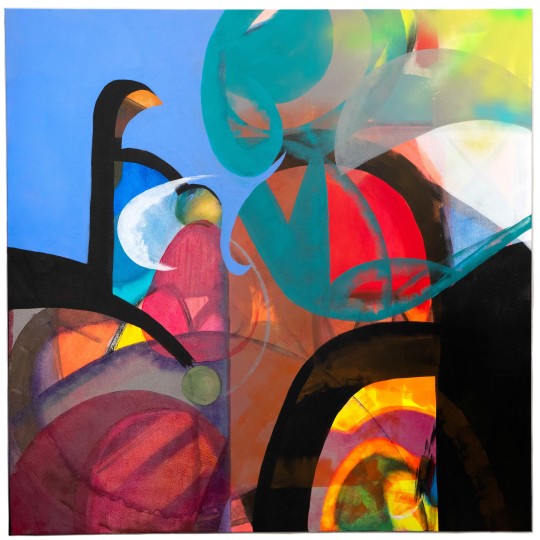
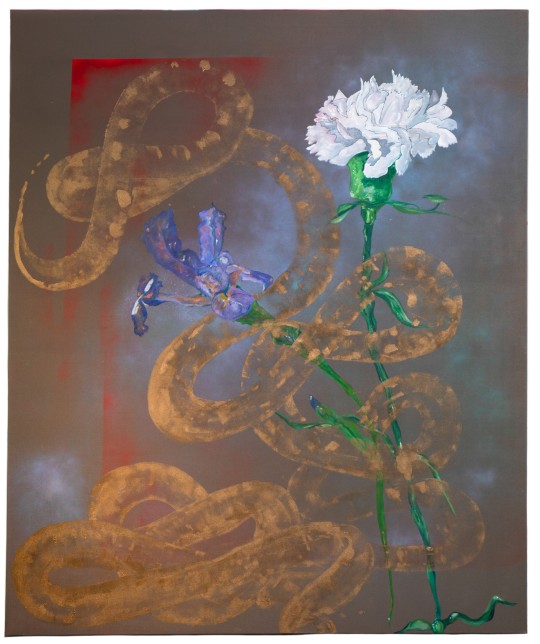




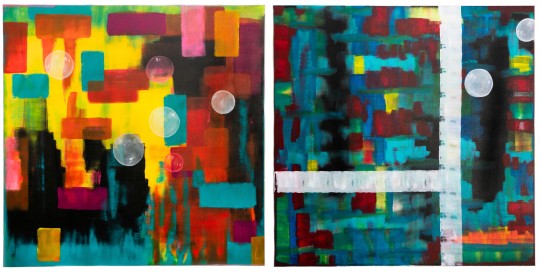






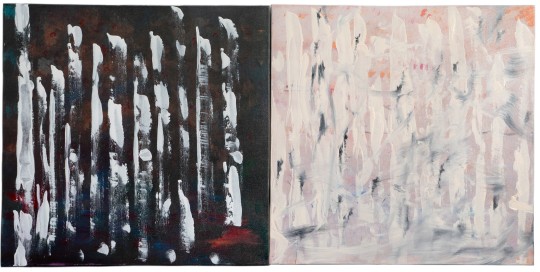
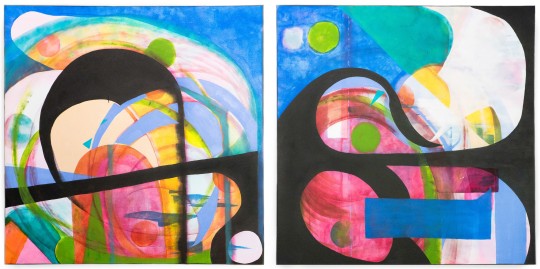


https://vimeo.com/878010744
0 notes
Text
Things to do Tampa Museum of Art
The Tampa Museum of Art is a cultural gem located in the heart of downtown Tampa, Florida. With its impressive collection and diverse exhibitions, the museum offers a delightful and enriching experience for art enthusiasts and visitors of all ages.
The museum's permanent collection showcases various captivating artworks from different periods and cultures. Visitors can explore multiple artistic expressions and styles, from ancient artifacts to contemporary masterpieces. The museum's American, European, and Asian collections and its photography and modern art sections provide a comprehensive journey through art history.
In addition to its permanent collection, the Tampa Museum of Art hosts rotating exhibitions featuring works by renowned artists worldwide. These temporary exhibitions offer a fresh and dynamic perspective on art, ensuring there's always something new and exciting to see with each visit.
The museum also features an innovative and interactive Art+Technology Lab, which explores the intersection of art and technology. This immersive space allows visitors to engage with digital and new media artworks, providing a glimpse into the future of artistic expression.
Families and children will enjoy the Art Spot, a creative space encouraging hands-on artmaking. Young visitors can unleash their creativity and imagination through various art activities and workshops in a fun and supportive environment.
The museum's riverfront location adds to the overall experience, with stunning views of the Hillsborough River and the Tampa skyline. The outdoor terrace provides a peaceful, relaxing spot to enjoy the picturesque surroundings.
Throughout the year, the Tampa Museum of Art hosts various cultural events, lectures, and workshops that complement its exhibitions. These programs foster a deeper appreciation and understanding of art, engaging the art community and the broader public.
The museum's award-winning building, designed by renowned architect Stanley Saitowitz, is a work of art. Its modern and innovative design perfectly complements the artwork within, creating a harmonious and inspiring environment for visitors.
Whether you're a seasoned art enthusiast or simply curious about exploring the art world, the Tampa Museum of Art offers a thought-provoking and visually stunning experience that celebrates the beauty and significance of artistic expression.
Please visit the business of one of our regular supporters.
Google Maps: https://goo.gl/maps/kDyT2X5HLAoKuyve7
TPA Van Rental
Address: 304 E Waters Ave, Tampa, FL 33604
Be sure to check out this attraction too!
0 notes